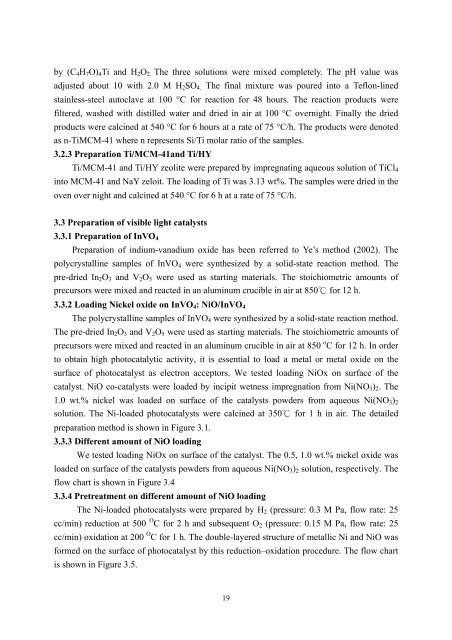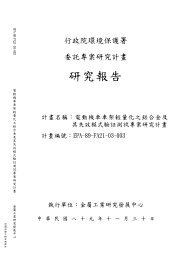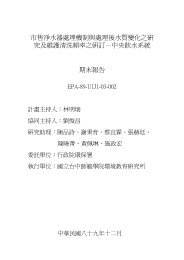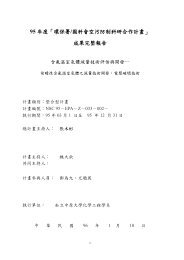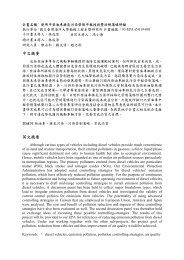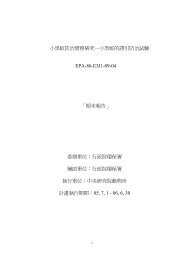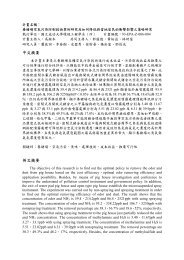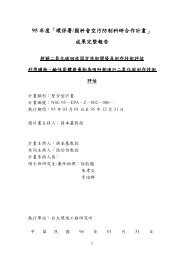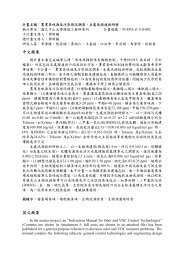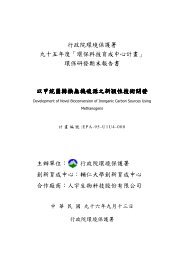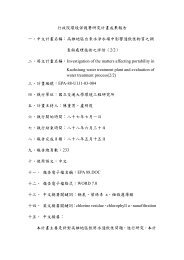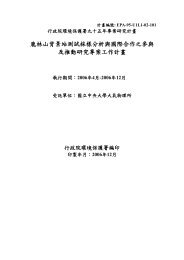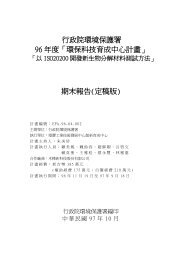NSC94-EPA-Z-008-004
NSC94-EPA-Z-008-004
NSC94-EPA-Z-008-004
- No tags were found...
You also want an ePaper? Increase the reach of your titles
YUMPU automatically turns print PDFs into web optimized ePapers that Google loves.
y (C 4 H 7 O) 4 Ti and H 2 O 2. The three solutions were mixed completely. The pH value wasadjusted about 10 with 2.0 M H 2 SO 4. The final mixture was poured into a Teflon-linedstainless-steel autoclave at 100 °C for reaction for 48 hours. The reaction products werefiltered, washed with distilled water and dried in air at 100 °C overnight. Finally the driedproducts were calcined at 540 °C for 6 hours at a rate of 75 °C/h. The products were denotedas n-TiMCM-41 where n represents Si/Ti molar ratio of the samples.3.2.3 Preparation Ti/MCM-41and Ti/HYTi/MCM-41 and Ti/HY zeolite were prepared by impregnating aqueous solution of TiCl 4into MCM-41 and NaY zeloit. The loading of Ti was 3.13 wt%. The samples were dried in theoven over night and calcined at 540 °C for 6 h at a rate of 75 °C/h.3.3 Preparation of visible light catalysts3.3.1 Preparation of InVO 4Preparation of indium-vanadium oxide has been referred to Ye’s method (2002). Thepolycrystalline samples of InVO 4 were synthesized by a solid-state reaction method. Thepre-dried In 2 O 3 and V 2 O 5 were used as starting materials. The stoichiometric amounts ofprecursors were mixed and reacted in an aluminum crucible in air at 850℃ for 12 h.3.3.2 Loading Nickel oxide on InVO 4 : NiO/InVO 4The polycrystalline samples of InVO 4 were synthesized by a solid-state reaction method.The pre-dried In 2 O 3 and V 2 O 5 were used as starting materials. The stoichiometric amounts ofprecursors were mixed and reacted in an aluminum crucible in air at 850 o C for 12 h. In orderto obtain high photocatalytic activity, it is essential to load a metal or metal oxide on thesurface of photocatalyst as electron acceptors. We tested loading NiOx on surface of thecatalyst. NiO co-catalysts were loaded by incipit wetness impregnation from Ni(NO 3 ) 2 . The1.0 wt.% nickel was loaded on surface of the catalysts powders from aqueous Ni(NO 3 ) 2solution. The Ni-loaded photocatalysts were calcined at 350℃ for 1 h in air. The detailedpreparation method is shown in Figure 3.1.3.3.3 Different amount of NiO loadingWe tested loading NiOx on surface of the catalyst. The 0.5, 1.0 wt.% nickel oxide wasloaded on surface of the catalysts powders from aqueous Ni(NO 3 ) 2 solution, respectively. Theflow chart is shown in Figure 3.43.3.4 Pretreatment on different amount of NiO loadingThe Ni-loaded photocatalysts were prepared by H 2 (pressure: 0.3 M Pa, flow rate: 25cc/min) reduction at 500 O C for 2 h and subsequent O 2 (pressure: 0.15 M Pa, flow rate: 25cc/min) oxidation at 200 O C for 1 h. The double-layered structure of metallic Ni and NiO wasformed on the surface of photocatalyst by this reduction–oxidation procedure. The flow chartis shown in Figure 3.5.19


